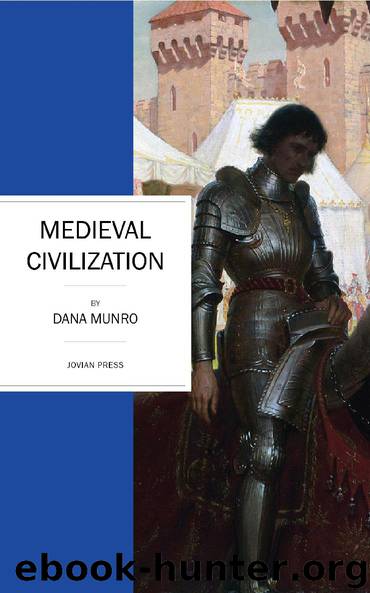Medieval Civilization by Dana Munro

Author:Dana Munro
Language: eng
Format: epub
Publisher: Pronoun
THE DEVELOPMENT OF THE ROMANCE LANGUAGES, ESPECIALLY THOSE OF FRANCE
..................
Adapted from A. Darmesteter: Cours de grammaire historique de la langue française
THE French language, like Portuguese, Spanish, Provençal, Italian, Ladin (spoken in the western Tyrol), and Rumanian, has been derived, through a long series of transformations, from Latin, the language of the Romans.
The Latin language underwent tremendous changes before it attained the perfection it enjoyed under Cicero, Livy, Tacitus, Lucretius, Vergil, and Horace. At all times there was a more or less marked divergence between the spoken and the written language, but the variation was, on the whole, slight during the republic and the empire.
The fifth century, however, witnessed a distinct decline in Latin literature and Roman greatness, and accompanying this decline a rapid and independent development of spoken Latin took place. Many constructions, many forms and words, which literary Latin, in the days of Rome’s greatness, had been too haughty or too conservative to adopt, now triumphed completely; and as numbers lay down the law in matters of language, and as the plebs formed the great majority of the nation, the ways of speaking which were current with the multitude now dominated. It is from this changing popular, or vulgar, Latin that the Romance tongues sprang; it would, perhaps, be more accurate to say that they are vulgar Latin, in its modern stages of development.
There was a remarkable uniformity in the vulgar Latin spoken from the Black Sea to the Atlantic, and from the banks of the Rhine to Mount Atlas; the grammar, syntax, and vocabulary were essentially the same. The pronunciation, of course, varied from place to place. The peoples of different races who had adopted Latin had forgotten their original tongues, but they could not discard their peculiarities of pronunciation.
Gradually, and under the action of complex causes, linguistic varieties assumed form. The most rapid and most characteristic modifications, those which gave to each country its own peculiar language, took place in the seventh, or at latest in the eighth, century. Certain words were in much more common use in one region than in another; words fully alive here were quite unknown or forgotten there; pronunciation took on a more marked character according to time and place, and syntax adopted slightly diverging constructions.
If, however, we consider their common characteristics rather than their differences, if we notice that they have practically the same vocabulary, declensions, and conju gations, the same usages in composition and derivation, and the same syntax, then the Romance languages are seen to be different aspects of one and the same language, varying from one another only as the blossoms of flowers planted in different soils on the same estate.
Each of the Romance languages retained, as its own property, independently of the others, the name Roman, which the people of Rome gave to their language. Even to-day the name is borne by the Rumanian and the Ladin, or Romanche: Provençal is called the Roman tongue, and the Provençal people think that their language has a special right to the name.
Download
This site does not store any files on its server. We only index and link to content provided by other sites. Please contact the content providers to delete copyright contents if any and email us, we'll remove relevant links or contents immediately.
| Africa | Americas |
| Arctic & Antarctica | Asia |
| Australia & Oceania | Europe |
| Middle East | Russia |
| United States | World |
| Ancient Civilizations | Military |
| Historical Study & Educational Resources |
Room 212 by Kate Stewart(5063)
The Crown by Robert Lacey(4754)
Endurance: Shackleton's Incredible Voyage by Alfred Lansing(4713)
The Iron Duke by The Iron Duke(4317)
The Rape of Nanking by Iris Chang(4162)
Joan of Arc by Mary Gordon(4049)
Killing England by Bill O'Reilly(3966)
Say Nothing by Patrick Radden Keefe(3930)
I'll Give You the Sun by Jandy Nelson(3389)
Shadow of Night by Deborah Harkness(3322)
Hitler's Monsters by Eric Kurlander(3283)
Mary, Queen of Scots, and the Murder of Lord Darnley by Alison Weir(3165)
Blood and Sand by Alex Von Tunzelmann(3159)
Eleanor & Park by Rainbow Rowell(3098)
Darkest Hour by Anthony McCarten(3088)
Margaret Thatcher: The Autobiography by Thatcher Margaret(3041)
Book of Life by Deborah Harkness(2889)
Red Famine: Stalin's War on Ukraine by Anne Applebaum(2887)
The One Memory of Flora Banks by Emily Barr(2824)
